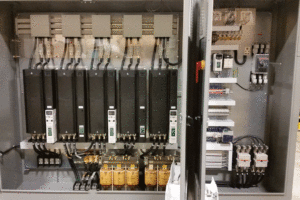High Speed Motor Dynamometer Controls
Mechanical Electrical Systems Inc. > Dynamometer > High Speed Motor Dynamometer Controls
We built the high speed dynamometer controls in this cabinet to the exact customer specification. This is for a prime automotive manufacturer to test servo motors. With our many years of experience, we are trusted to perform in the most rigorous of testing capacities.
A high-speed dynamometer is a device used to measure and control the torque and rotational speed of a motor or engine under various conditions. The controls for a high-speed dynamometer are crucial for accurate testing and simulation of real-world operating conditions. Here are some key aspects of high-speed dynamometer controls:
- Torque Control:
- Proportional-Integral-Derivative (PID) Control: This is a common control method that adjusts the torque output based on the difference between the desired and actual torque values.
- Feedforward Control: This anticipates the torque changes based on the known characteristics of the system, enabling quicker responses to load changes.
- Speed Control:
- PID Control: Similar to torque control, PID control is often used to regulate the speed of the dynamometer motor.
- Feedforward Control: Anticipates speed changes based on the known system dynamics.
- Load Control:
- Load Regulation: Dynamometers should be capable of maintaining a constant load on the engine or motor, even as speed and torque change.
- Manual and Automatic Load Adjustments: Operators may manually set loads for specific tests, or the dynamometer may automatically adjust the load to maintain a constant condition.
- Cooling Systems:
- Temperature Control: High-speed dynamometers generate a significant amount of heat. Controls for cooling systems, such as fans or liquid cooling, are essential to prevent overheating during prolonged testing.
- Data Acquisition:
- Real-time Data Monitoring: Dynamometer controls should include a system for real-time monitoring of key parameters such as torque, speed, power, and temperature.
- Data Logging: The ability to log data for later analysis is crucial for understanding the performance of the engine or motor under different conditions.
- Safety Features:
- Emergency Stop: A quick and easily accessible emergency stop button is necessary for safety.
- Overload Protection: Safeguards to prevent damage to the dynamometer or the system under test in case of unexpected overloads.
- User Interface:
- Intuitive Interface: The controls should have a user-friendly interface for setting up tests, adjusting parameters, and monitoring results.
- Remote Control: Some systems may offer remote control capabilities for convenience and safety.
- Control Software:
- Dynamometer Control Software: Specialized software for controlling the dynamometer and collecting data is essential. This software often includes features for test setup, calibration, and analysis.
- Calibration:
- Calibration Controls: Dynamometers need to be regularly calibrated to ensure accurate and reliable measurements. Calibration controls and procedures should be integrated into the system.
- Integration with Test Cell Systems:
- Compatibility: The dynamometer controls should be compatible with other systems in a test cell, such as fuel and air supply systems, emissions measurement devices, and more.
It’s important to note that the specific controls and features can vary based on the type of dynamometer (e.g., eddy current, hydraulic, electric), the application, and the complexity of the testing requirements. Mechanical Electrical Systems manufactures high-speed dynamometers and provide detailed documentation on the control systems and offer support for integration into testing setups.
- Categories: Dynamometer
- Tags: dynamometer controls, high speed dynamometer control, high speed dynamometer controls, regen dynamometer

